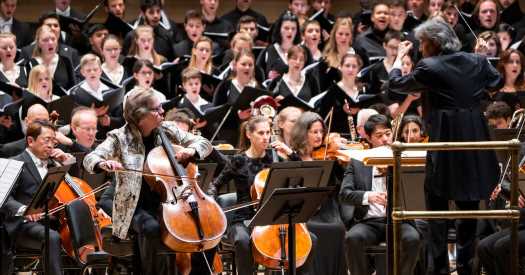“Go big or go home” must have been the rallying cry for the Hamburg Philharmonic State Orchestra’s debut at Carnegie Hall Saturday night. The last time this group appeared in the United States was more than 50 years ago, in 1967. So for this program, the Hamburg musicians, led by the conductor Kent Nagano, went large-scale ambitious, performing the world premiere of the American composer Sean Shepherd’s t12- movement “An Einem Klaren Tag — On a Clear Day” for cello, choruses and orchestra.
Here, that ambition demanded the participation of no fewer than five choruses culled from both Germany and New York: the Audi Jugendchorakademie (a youth chorus sponsored by the car manufacturer); Alsterspatzen (the children and youth choir of the Hamburg State Opera); the Dresdner Kreuzchor (a boys’ choir that dates back to the 13th century); the Young ClassX ensemble (a youth choir from Hamburg); and the Young New Yorkers’ Chorus. By my count, more than 200 instrumentalists and singers were jammed onto the Carnegie stage, plus Nagano and the soloist Jan Vogler on cello, for the nearly hourlong work.
The concert began with the music of a Hamburg native: Johannes Brahms. The orchestra performed his brief, sonically luminous and emotionally ambiguous “Schicksalslied” (Song of Destiny) with the Audi singers. Written in three movements with an ancient Greek-inspired text by Friedrich Hölderlin, “Schicksalslied” descends from radiant joyfulness into dark despair before resolving into something akin to solace. Nagano, deeply mindful of shape and phrasing, coaxed the strings into producing a warm glow that seemed to be lit from within.
Nagano and the orchestra continued that careful, deeply intentional sculpting of rhythm, articulation and dynamics in Beethoven’s Symphony No. 8. In a work full of lithe charm, the Hamburg musicians, who also serve as the orchestra of the Hamburg State Opera, were able to showcase a more exuberantly playful side of their collective personality. After all, this is a symphony in which Beethoven, for all his callbacks to the structure and style of Haydn and Mozart, takes a radical tack: the Eighth lacks a slow movement, and dances at its own singular pace. Even with that whimsical spirit, the musicians created each moment with great deliberation.
That pinpoint precision subsided in the sweep of Shepherd’s massive and earnest piece. Mostly using poetry by the German writer Ulla Hahn, Shepherd calls “On a Clear Day” both “a plea for compassion toward our fellow human” and an outcry against environmental calamity. Despite Vogler’s presence, it’s not a concerto per se; rather, Shepherd used the cello more as an actor who steps into a variety of roles to present occasional plaintive and virtuosic soliloquies against a colossal backdrop: here, a melancholic companion for the singers, trading a melody back and forth; there, channeling the spirit of a beleaguered Mother Earth.
Shepherd has a fantastic gift for orchestral color; for example, in the sixth movement, he juxtaposes a rapturous, lyrical passage for solo cello with winds, brass, harp, piano and percussion — including glockenspiel and sleigh bells — to glittering, mysterious effect. The piece is so expansive in both size and scope, however, that it sometimes felt like Nagano was less a conductor than the captain of a giant cruise ship, wrestling his oversized vessel into a modest port. The even keel at which he had led the Brahms and Beethoven had vanished.
Hamburg Philharmonic State Orchestra
Performed on Saturday at Carnegie Hall, Manhattan; carnegiehall.org.
Source: Read Full Article
